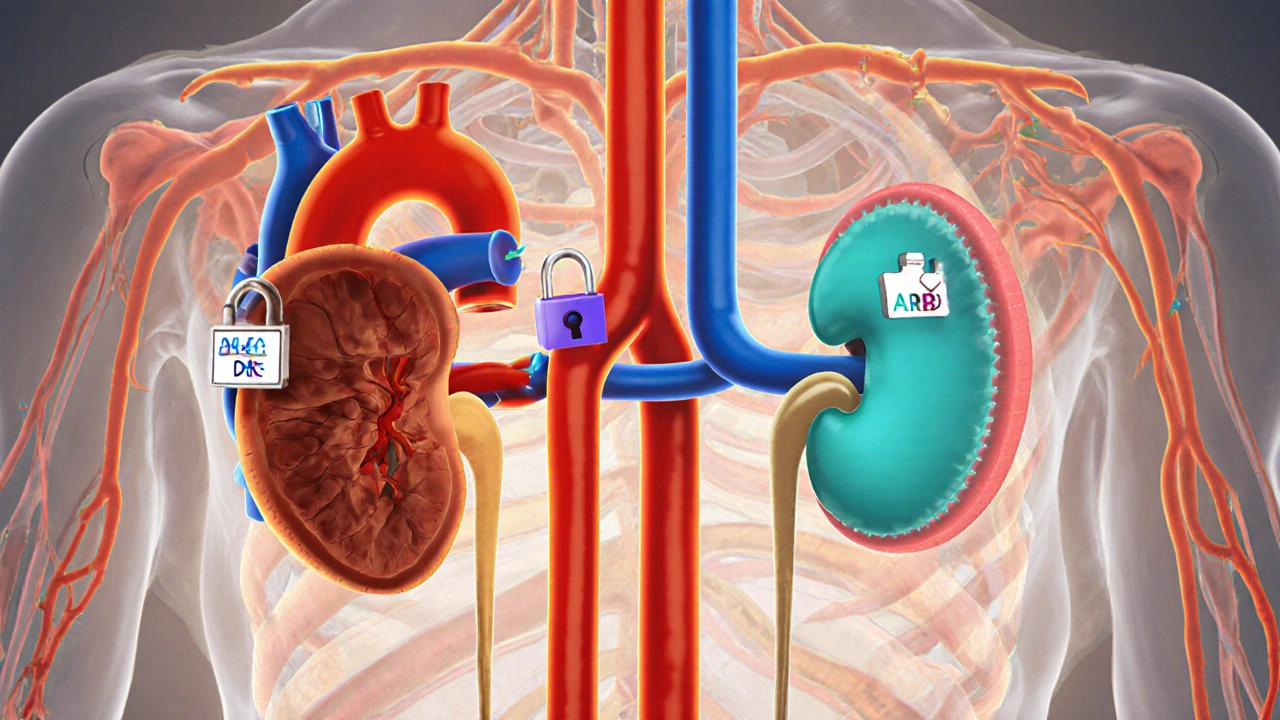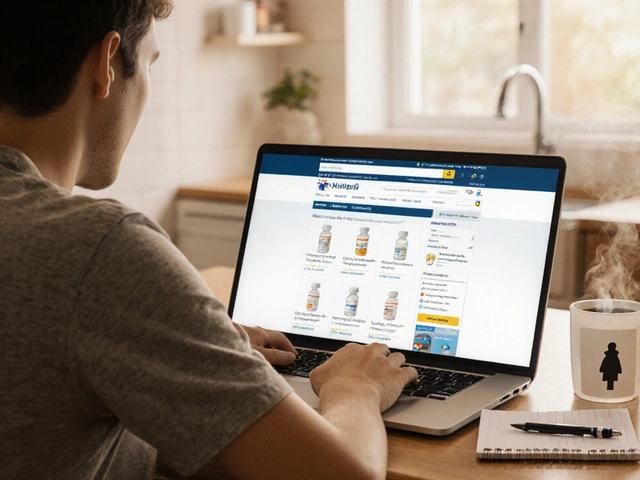Coversyl vs Other Blood Pressure Drugs Comparison Tool
Recommended Medication Based on Your Profile
Click "Compare Medications" to see personalized recommendations.
| Drug | Typical Dose (mg) | Half-Life | Approved Uses | Common Side Effects | UK Approx. Monthly Cost (£) |
|---|---|---|---|---|---|
| Coversyl | 2-8 | 3-5 hours (active metabolite 30-35 hours) | Hypertension, stable CAD, CKD | Cough, dizziness, hyperkalemia | 8-10 |
| Enalapril | 5-20 | 11 hours | Hypertension, heart failure | Cough, rash, hypotension | 6-9 |
| Lisinopril | 10-40 | 12 hours | Hypertension, post-MI | Cough, taste disturbances | 7-11 |
| Ramipril | 2.5-10 | 13-17 hours | Hypertension, heart failure, CAD | Cough, fatigue | 9-12 |
| Losartan | 50-100 | 2 hours (active metabolite 6-9 hours) | Hypertension, diabetic nephropathy | Headache, hyperkalemia, edema | 5-8 |
Quick Takeaways
- Coversyl (perindopril arginine) is an ACE inhibitor with a long half‑life, making once‑daily dosing reliable.
- It is especially effective for hypertension, stable coronary artery disease, and chronic kidney disease.
- When compared with other ACE inhibitors (enalapril, lisinopril, ramipril) and an ARB (losartan), Coversyl shows similar blood‑pressure reduction but a slightly better tolerability profile in older adults.
- Cost in the UK is moderate - about £8‑£10 for a 30‑day supply of the 5mg tablet.
- Choosing the right drug depends on kidney function, cough risk, once‑daily convenience, and any concomitant medicines.
When it comes to blood‑pressure control, Coversyl is a popular choice, but patients often wonder how it stacks up against other options. This guide walks through the science, side‑effects, dosing, and price points so you can decide if Coversyl fits your needs or if an alternative might be a better match.
Coversyl is the brand name for perindopril arginine, an angiotensin‑converting‑enzyme (ACE) inhibitor approved for hypertension, heart failure, and prevention of cardiovascular events. It works by blocking the conversion of angiotensin‑I to angiotensin‑II, a potent vasoconstrictor, thereby relaxing blood vessels and lowering blood pressure.
How Coversyl Works
The renin‑angiotensin‑aldosterone system (RAAS) regulates blood‑pressure and fluid balance. By inhibiting ACE, perindopril reduces angiotensin‑II levels, which leads to vasodilation, decreased aldosterone secretion, and reduced sodium retention. This triple effect helps keep the heart’s workload lower and protects the kidneys from high‑pressure damage.
Common Alternatives to Coversyl
Most alternatives belong to the same ACE‑inhibitor class or to the closely related angiotensin‑II receptor blocker (ARB) class. Below are the most frequently prescribed peers.
Enalapril is a short‑acting ACE inhibitor often started at 5mg once daily and titrated up to 20mg.
Lisinopril offers once‑daily dosing with a long half‑life of about 12hours and is popular in the United States.
Ramipril is another long‑acting ACE inhibitor with proven benefits in post‑myocardial‑infarction patients.
Captopril was the first ACE inhibitor on the market; it requires multiple daily doses because of its short half‑life.
Losartan is an ARB that blocks the angiotensin‑II receptor directly, offering a cough‑free alternative for patients who cannot tolerate ACE inhibitors.
Side‑Effect Profile Comparison
All ACE inhibitors share a core set of possible side effects, yet the frequency and severity can vary. The most common are dry cough, elevated potassium, and occasional dizziness. ARBs like losartan avoid the cough but may cause slightly more peripheral edema.
| Drug | Typical Dose (mg) | Half‑Life | Approved Uses | Common Side Effects | UK Approx. Monthly Cost* |
|---|---|---|---|---|---|
| Coversyl | 2‑8 | 3‑5hours (active metabolite 30‑35hours) | Hypertension, stable CAD, CKD | Cough, dizziness, hyperkalemia | £8‑£10 |
| Enalapril | 5‑20 | 11hours | Hypertension, heart failure | Cough, rash, hypotension | £6‑£9 |
| Lisinopril | 10‑40 | 12hours | Hypertension, post‑MI | Cough, taste disturbances | £7‑£11 |
| Ramipril | 2.5‑10 | 13‑17hours | Hypertension, heart failure, CAD | Cough, fatigue | £9‑£12 |
| Losartan | 50‑100 | 2hours (active metabolite 6‑9hours) | Hypertension, diabetic nephropathy | Headache, hyperkalemia, edema | £5‑£8 |
*Prices based on UK NHS prescriber formularies, July2025; actual cost may vary by pharmacy.

Choosing the Right Drug - Decision Criteria
Below is a practical checklist you can run through with your clinician.
- Kidney Function: If eGFR < 30mL/min, a lower dose or an ARB may be safer.
- Cough Sensitivity: Patients with a history of ACE‑inhibitor cough often switch to losartan.
- Dosage Convenience: Once‑daily pills (Coversyl, Lisinopril, Ramipril) are preferable for adherence.
- Cardiovascular Risk Profile: Coversyl has specific evidence for reducing events in stable coronary artery disease.
- Cost Considerations: If budget is tight, generic enalapril or losartan may be cheaper.
- Drug Interactions: Check for potassium‑sparing diuretics, NSAIDs, or lithium, which raise the risk of hyperkalemia.
Safety Highlights and Contra‑Indications
All ACE inhibitors, including Coversyl, should be avoided in pregnancy because they can cause fetal renal damage. They’re also contraindicated in patients with a known history of angio‑edema related to previous ACE‑inhibitor use. For those with bilateral renal artery stenosis, ACE inhibition can precipitate acute renal failure.
Monitoring recommendations:
- Check serum creatinine and potassium 1‑2 weeks after initiation or after any dose change.
- Assess blood pressure weekly until stable.
- Educate patients to report persistent dry cough or swelling of the lips/tongue immediately.
Real‑World Example
John, a 68‑year‑old retired teacher from Bristol, was diagnosed with hypertension and stage3 chronic kidney disease (eGFR35). His GP started him on Coversyl 4mg once daily because the drug’s renal‑protective data matched his profile. After three months, John’s blood pressure fell from 152/92mmHg to 128/78mmHg, and his eGFR remained stable. He tolerated the medication well, reporting no cough. When his pharmacy offered a generic enalapril at a lower price, his doctor considered switching, but decided to keep Coversyl because the evidence for renal protection is strongest with perindopril.
When to Consider an Alternative
If you experience any of the following, discuss a switch with your clinician:
- Persistent dry cough that interferes with sleep.
- Recurrent high potassium levels (>5.5mmol/L).
- Development of angio‑edema.
- Need for a cheaper generic option and no specific renal‑protective requirement.
Summing Up the Comparison
Coversyl holds its own against other ACE inhibitors in blood‑pressure reduction, while offering a slight edge for patients with coronary artery disease or moderate chronic kidney disease. Its once‑daily regimen aids adherence, and its cost sits in the mid‑range of NHS‑prescribed drugs. If cough or kidney concerns dominate, an ARB such as losartan may be preferable.

Frequently Asked Questions
Can I take Coversyl with a diuretic?
Yes. Combining an ACE inhibitor with a thiazide or loop diuretic is common for synergistic blood‑pressure control. Just watch potassium levels, especially if the diuretic is potassium‑sparing.
What should I do if I develop a dry cough on Coversyl?
Report it to your doctor. They may switch you to an ARB like losartan, which typically eliminates the cough while still controlling blood pressure.
Is Coversyl safe during pregnancy?
No. ACE inhibitors are contraindicated in pregnancy because they can cause fetal renal failure, skull hypoplasia, and even death. Pregnant patients should use a medication approved for gestational hypertension, such as methyldopa.
How quickly does Coversyl start working?
Blood‑pressure lowering can be observed within 2‑4hours of the first dose, with full effect usually reached after 2‑3weeks of consistent therapy.
Can I take Coversyl if I have diabetes?
Absolutely. In fact, ACE inhibitors like Coversyl are often preferred for diabetic patients because they protect kidney function and reduce the risk of cardiovascular events.






Christian James Wood
I've read more about ACE inhibitors than most people read about their favorite sports team, and let me tell you, the hype around Coversyl is seriously overblown.
First, the half‑life story is tossed around like a badge of honor, yet in real‑world practice the difference between a three‑hour and an eleven‑hour agent is negligible for most patients.
Second, the claim that Coversyl offers superior renal protection is based on a handful of subgroup analyses that never survived the rigor of a head‑to‑head trial.
Third, the side‑effect profile-dry cough, dizziness, hyperkalemia-remains virtually identical across the ACE class, so picking perindopril for “better tolerability” is a marketing ploy.
Fourth, the cost argument collapses once you factor in generic enalapril, which can be purchased for pennies per dose, making the £8‑£10 price tag look extravagant.
Fifth, the once‑daily dosing convenience is a convenience myth; adherence is driven by patient education, not by whether you take a pill at 8 am or 8 pm.
Sixth, the literature you’ll find praising Coversyl’s impact on coronary artery disease is riddled with industry‑funded papers that gloss over competing evidence.
Seventh, the guideline committees that recommend perindopril do so because of historical inertia, not because of any groundbreaking mechanism.
Eighth, the ARB alternative, losartan, sidesteps the cough issue entirely and costs virtually the same in the NHS formulary.
Ninth, the supposedly “active metabolite” lingering for 30‑35 hours is pharmacologically inert for the most part.
Tenth, patient anecdotes about “miracle drops” are anecdotal at best and often ignore concomitant lifestyle changes.
Eleventh, clinicians who swear by Coversyl often have prescribing habits formed before newer agents entered the market.
Twelfth, the table you posted glosses over drug interactions with potassium‑sparing diuretics, which can be lethal if overlooked.
Thirteenth, I’ve seen no convincing data that perindopril reduces mortality beyond what any ACE inhibitor already does.
Fourteenth, when the kidneys are already compromised, the safest route is often to switch to an ARB rather than shuffle between ACEs.
Fifteenth, the “evidence for stable CAD” is based on surrogate endpoints, not hard outcomes.
Finally, if you want a truly evidence‑based choice, look beyond brand names and focus on individual patient factors, not marketing fluff.
Rebecca Ebstein
Wow, that's a ton of info! i think u gotta remember that every body reacts diffirently, so it's good to have a few options on the table.
even if one drug feels like a gamble, there's usually a backup that works just as well.
Artie Alex
From a pharmacodynamic perspective, the inhibition constant (Ki) of perindopril relative to other ACE inhibitors demonstrates a comparable affinity for the active site of angiotensin‑converting enzyme, thereby yielding analogous reductions in angiotensin‑II synthesis.
Nevertheless, the clinical heterogeneity observed across randomized controlled trials can be attributed to variations in study populations, baseline renal function, and concomitant antihypertensive regimens, which collectively confound direct comparative efficacy assessments.
Moreover, the pharmacokinetic profile, inclusive of prodrug conversion efficiency and metabolite half‑life, does not substantively differentiate perindopril from its class counterparts in terms of therapeutic outcomes.
abigail loterina
That's a solid summary – basically, pick what fits your routine and health needs, and keep an eye on your kidneys and potassium.
Roger Cole
Look at the costs and side effects, then decide.
Krishna Garimella
Hey folks, just wanted to add that sometimes the best choice isn’t about the fancy stats but about what you can actually stick to day after day.
If you’re juggling work, family, and maybe a side hustle, a once‑daily pill can be a game‑changer for adherence.
On the other hand, if you’re already tracking your BP at home and have a good rapport with your pharmacist, a cheaper generic like enalapril might make more sense financially.
Also, remember that lifestyle tweaks – less salt, more exercise, stress management – amplify whatever drug you’re on, often letting you stay on a lower dose.
nalina Rajkumar
Great breakdown! 😊👍 Coversyl looks solid, but if you get that pesky cough, just switch to losartan – no drama! 🤷♀️💊
Michael Barrett
Well... honestly,,, it's not rocket science; all these ACE inhibitors do the same thing – block ACE – so pick the one that fits your budget and side‑effect tolerance!!!
Inma Sims
Indeed, the saga of perindopril versus its peers reads like an epic novel, but in practice the heroics are often overstated; a pragmatic clinician will simply match the drug to the patient's comorbidities and financial constraints, avoiding the theatrics of brand‑centric devotion.
Gavin Potenza
Honestly, I get why people get all philosophical about drug choice – it's like picking a favorite coffee bean – but at the end of the day, the blood pressure numbers are what matter, so keep it simple and let the data guide you.
Virat Mishra
All this stuff is just pharma fluff.
Daisy Aguirre
Listen up, friends! 🌈 If you’re sick of the usual cough drama and want something that actually respects your wallet, give Coversyl a shot – it’s got that sweet spot of potency and price, and hey, if it doesn’t vibe with you, the ARB squad is waiting with open arms.
Natalie Kelly
Exactly, try it and see how you feel.